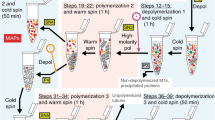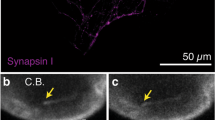Summary
Microtubule protein prepared from bovine brain by a temperature-dependent assembly-disassembly procedure contained Mg2+-or Ca2+-stimulated ATPase activity. However, activity decreased with successive cycles of assembly-disassembly such that 15% of the Mg2+-stimulated and 31% of the Ca2+-stimulated activity of the second-cycle material remained after seven cycles. Microtubule preparations purified by three cycles of assembly-disassembly contained many membrane fragments and vesicles which were absent in microtubule preparations cycled eight times. Histochemistry and electron microscopy revealed that much of the activity is associated with the vesicles. Vesicles with an accumulation of lead phosphate deposits (indication of ATPase activity) were observed in high-speed pellets (150,000 g, 60 min) of microtubule-associated proteins. Most of the activity in the microtubule-associated protein preparations, but only a fraction of the total protein is pelleted. 53–78% of the ATPase activity, but only 6% of the total protein, is recovered in a microtubule-associated protein fraction eluted from phosphocellulose with 0.17 M NaCl. Polypeptides resolved on SDS polyacrylamide gradient gels have estimated molecular weights of 30,000–76,000. Electron micrographs of this material revealed short filaments, vesicles, and small ring-like structures. None of the inhibitors of possible contaminating ATPases affected the ATPase activity.
Similar content being viewed by others
References
Bhattacharyya B, Wolff J (1975) Membrane-bound tubulin in brain and thyroid tissue. J Biol Chem 250: 7639–7649
Bhattacharyya B, Wolff J (1976) Polymerization of membrane tubulin. Nature 264: 576–577
Bird MM (1976) Microtubule-synaptic vesicle associations in cultured rat spinal cord neurons. Cell Tissue Res 168: 101–115
Borisy GG, Olmsted JB, Marcum JM, Allen C (1974) Microtubule assembly in vitro. Fed Proc 33: 167–174
Burns RG, Pollard TD (1974) A dynein-like protein from brain. FEBS Lett 40: 274–280
Daleo GR, Piras MM, Piras R (1974) The presence of phospholipids and diglyceride kinase activity in microtubules from different tissues. Biochem Biophys Res Commun 61: 1043–1050
Feit H, Shay JW (1980) The assembly of tubulin into membranes. Biochem Biophys Res Commun 94: 324–331
Franke WW (1971) Cytoplasmic microtubules linked to endoplasmic reticulum with crossbridges. Exp Cell Res 66: 486–489
Gaskin F, Kramer SB, Cantor CR, Adelstein R, Shelanski ML (1974) A dynein-like protein associated with neurotubules. FEBS Lett 40: 281–286
Gelfand VI, Gyoeva FK, Rosenblat VA, Shahina NA (1978) A new ATPase in cytoplasmic microtubule preparations. FEBS Lett 88: 197–200
Gray EG (1975) Presynaptic microtubules and their association with synaptic vesicles. Proc R Soc Lond B 190: 369–372
Järlfors U, Smith DS (1969) Association between synaptic vesicles and neurotubules. Nature 224: 710–711
Karnovsky MJ (1965) A formaldehyde-glutaraldehyde fixative of high osmolality for use in electron microscopy. J Cell Biol 27: 137–138
Lagnado JR, Kirazov EK (1975) Studies on the phosphorylation of brain microtubule protein and microtubule-associated phospholipids. In: Borgers M, DeBrabander M (eds) Microtubules and microtubule inhibitors. North Holland, Amsterdam, pp 127–140
Larsson H, Wallin M, Edström A (1976) Induction of a sheet polymer of tubulin by Zn2+. Exp Cell Res 100: 104–110
Larsson H, Wallin M, Edström A (1979) Some characteristics of ATPase activity in a brain microtubule protein preparation. J Neurochem 33: 1249–1258
Ledig M, Ciesielski-Treska J, Cam Y, Montagnon D, Mandel P (1975) ATPase activity of neuroblastoma cells in culture. J Neurochem 25: 635–640
Lowry OH, Rosebrough NJ, Farr AL, Randall RJ (1951) Protein measurement with the Folin phenol reagent. J Biol Chem 193: 265–275
Nath J, Flavin M (1978) A structural difference between cytoplasmic and membrane-bound tubulin of brain. FEBS Lett 95: 335–338
O'Farrell PH (1975) High-resolution two-dimensional electrophoresis of proteins. J Biol Chem 250: 4007–4021
Prus K, Wallin M (1982) Microtubule-associated ATPase: fact or artifact? In: Weiss D (ed) Axoplasmic transport. Springer, Berlin Heidelberg New York, pp 91–98
Raine CS, Ghetti B, Shelanski ML (1971) On the association between microtubules and mitochondria within axons. Brain Res 34: 389–393
Senior AE (1973) The structure of mitochondrial ATPase. Biochim Biophys Acta 301: 249–277
Sharp GA, Fitzsimons JTR, Kerkut GA (1980) Electron microscopic localization of an ATPase associated with microtubules in the cerebral cortex of the rat. Comp Biochem Physiol 66: 415–429
Sherline P, Lee Y-C, Jacobs LS (1977) Binding of microtubules to pituitary secretory granules and secretory granule membranes. J Cell Biol 72: 380–389
Sloboda RD, Dentler WL, Rosenbaum JL (1976) Microtubule-associated proteins and the stimulation of tubulin assembly in vitro. Biochemistry 15: 4497–4505
Smith DS, Järlfors U, Cameron BF (1975) Morphological evidence for the participation of microtubules in axonal transport. Ann NY Acad Sci 253: 472–506
Smith RS (1980) The short term accumulation of axonally transported organelles in the region of localized lesions of single myelinated axons. J Neurocytol 9: 39–65
Suprenant KA, Dentler WL (1982) Association between endocrine pancreatic secretory granules and in vitro assembled microtubules is dependent upon microtubule-associated proteins. J Cell Biol 93: 164–174
Wachstein M, Meisel E (1957) Histochemistry of hepatic phosphatases at physiologic pH. Am J Clin Pathol 27: 13–23
Webb BC (1979) An ATPase activity associated with brain microtubules. Arch Biochem Biophys 198: 292–303
Weil-Malherbe H, Green RH (1951) The catalytical effect of molybdate on the hydrolysis of organic phosphate bonds. Biochem J 49: 286–292
Weingarten MD, Lockwood AH, Hwo S-Y, Kirschner MW (1975) A protein factor essential for microtubule assembly. Proc Natl Acad Sci USA 72: 1858–1862
White HD, Coughlin BA, Purich DL (1980) Adenosine triphosphatase activity of bovine brain microtubules. J Biol Chem 255: 486–491
Zisapel N, Levi M, Gozes I (1980) Tubulin: an integral protein of mammalian synaptic vesicle membranes. J Neurochem 34: 26–32
Author information
Authors and Affiliations
Rights and permissions
About this article
Cite this article
Prus, K., Wallin, M. The ATPase activity in brain microtubule preparations is membrane-associated. Histochemistry 78, 181–194 (1983). https://doi.org/10.1007/BF00489497
Received:
Issue Date:
DOI: https://doi.org/10.1007/BF00489497




